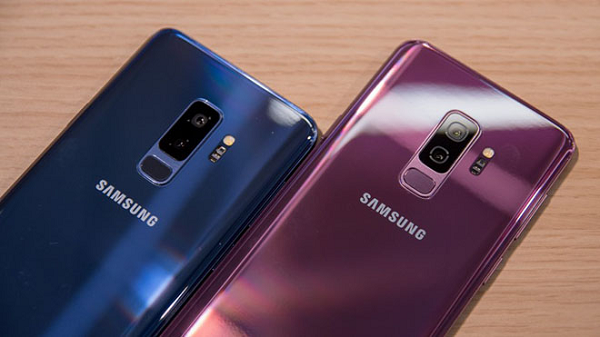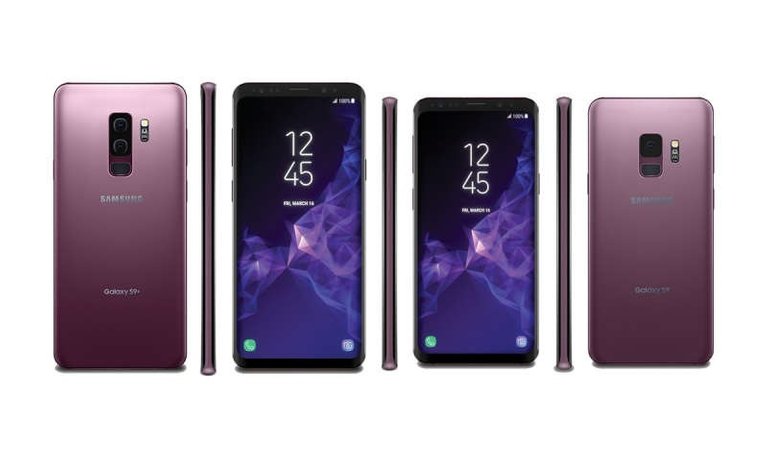Samsung Galaxy S9 PLUS
The Galaxy S9 Plus not only brings the dual-camera features of the Galaxy Note 8, but improves them with a variable aperture. In addition, it is more compact, your fingerprint reader is better located than before and brings more RAM than the Galaxy S9.
It's true, the Samsung Galaxy S9 ($ 719.99 on Amazon.com) does not have a dual camera or 6GB of RAM like the Galaxy S9 Plus ($ 839.99 on Amazon.com) or like the Galaxy Note 8 ($ 929.99 on Amazon.com), nor does it revolutionary changes compared to its predecessor. But its compact size and a group of specifications and functions make it a very attractive cell phone.

The Galaxy S9 was left with a single rear camera, unlike the S9 Plus that has two.
The first, and probably the most important thing for many, is that Samsung corrected the positioning of the fingerprint reader so that it is now more towards the center of the back, instead of being right next to the camera.
Second, the Galaxy S9 shares the same Snapdragon 845 processor (or Exynos 9810, depending on the market) of the S9 Plus, which are superior to the Snapdragon 835 (or Exynos 8895) Note 8. In addition, it has the same version of Android Oreo ( with custom interface), design and main functions of the Galaxy S9 Plus for a lower price (up to US $ 150 less). Even the Galaxy S9 has the same camera as the main camera with variable aperture of the Galaxy S9 Plus.

This means that it has the new slow-motion
video recording that allows Samsung to be placed on the Sony and Apple terrain (with slow motion recording of 960fps in HD and 240fps in Full HD), while also bringing double horn with technology of Dolby Atmos, the emojis animated AR Emojis and Bixby with more augmented reality features. Also, the cell phone serves as the basis to launch the new app of Samsung's SmartThings platform.
With the improvements and the small changes, it is clear that Samsung played it safe here, correcting the biggest criticism of its flagship phone and adding some news that are not necessarily for everyone.
Samsung Galaxy S9: Features and specifications
Screen: 5.8 inches (6.2 inches (S9 PLUS))
Resolution: 2,960x1,440 pixels
Processor: 845 eight-core Snapdragon (four 2.8GHz and 1.7GHz four) or Exynos 9810 eight-core (four 2.7GHz and 1.7GHz four) - depending on the market
RAM: 4GB
Storage: 64GB, 128GB and 256GB (varies by market, for example, only the 64GB version is sold in the US)
MicroSD slot: Yes (certified up to 400GB)
Battery: 3,000mAh (not removable)
Operating System: Android Oreo
Fast loading: Quick Charge 2.0
Wireless charging: Yes
Connectivity: Wi-Fi 802.11ac (2.4 and 5GHz) MU-MIMO, Bluetooth 5.0
Samsung Pay: Yes, through NFC and MST
Unlocking functions: Intelligent Scan, iris scanner, face recognition, pattern, PIN, password
Speakers: Two stereo with Dolby Atmos technology optimized by AKG
Rear camera: 12 megapixels with optical image stabilization and variable aperture from f / 1.5 to f / 2.4
Front camera: 8 megapixels with aperture f / 1.7
Water resistant: IP68 (up to 1.5 meters deep for up to 30 minutes)
Other features: USB-C; it has preinstalled the new SmartThings app; Google Pay; the screen detects the pressure in the area of the Start button; continues to integrate Bixby with its dedicated button that can not be reconfigured in an official way; Google Assistant; heart rate sensor; and it's compatible with the current VR Gear VR glasses and with Samsung DeX and DeX Pad
Size: 147.7x68.7x8.5mm
Weight: 163 grams

Galaxy S9: Is it necessary to upgrade from the S8 and S7 to the new Samsung phone?
It does not matter which Galaxy model you have, I will simply give you my best advice.
The Galaxy S9 and S9 Plus cell phones are, without a doubt, the best phones Samsung has ever made, and they are here. On March 16, the company's new flagship phones brought their sophisticated variable aperture cameras (and stereo speakers!) To stores around the world.
But is it worth the upgrade if you already have a Galaxy S8 or a Galaxy S7, or even a recent Galaxy Note with its sleek stylus?
What you earn with the Galaxy S9
Variable aperture camera (f / 1.5 and f / 2.4) to let in more or less light, as needed
Very balanced photos in bright outdoor situations
Slightly better photos (but occasionally more blurry) in low light situations
Second camera with 2x telephoto lens (only the Galaxy S9 Plus)
Slow motion video of 960 fps (240 fps at 1080p)
A better position for the posterior fingerprint sensor
Stereo speakers (it's also 40 percent stronger than the S8)
A slightly faster processor
2GB of extra memory (only the Galaxy S9 Plus)
15 percent brighter screen
Slightly thinner screen bezels (1.2 mm)
Android 8.0 Oreo (in case your phone is still waiting for you)
A new color option: purple lilac
LTE Internet faster, when available (1.2 Gigabit versus 1 Gigabit)
128GB and 256GB memory options globally
AR Emoji (which is not so good)
What stays the same
Virtually everything else is included:
Aluminum chassis with curved glass front and back
Excellent 5.8 inch super definition screen (Galaxy S9) or 6.2 inches (Galaxy S9 Plus)
Battery capacity: 3,000mAh (Galaxy S9) or 3,500mAh (Galaxy S9 Plus)
Second camera with 2x telephoto lens (only Galaxy S9 Plus)
IP68 water and dust resistant
Face and iris scanning (although they are now combined in Intelligent Scan)
Bixby button
Wireless charging
Expandable MicroSD storage
Input for hearing aids
What you will lose if you upgrade to the Galaxy S9
Consistent photo quality: the Galaxy S9 sometimes loses photos in low light
Slightly thinner, lighter: the S9 and S9 Plus are slightly thicker and heavier
Higher structure: S9 and S9 Plus are slightly shorter and wider
The money you will spend to buy a new phone so soon after your last purchase